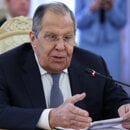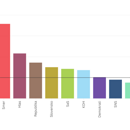BRATISLAVA (SITA) -- Appointing Miroslav Maxon as finance minister hoisted the number of Slovak Cabinet members to 19 and reinforced Slovakia's leading position in Central Europe as to the number of cabinet ministers. Hungary is happy with 14 ministers while 16 cabinet members manage Austria. The Czech and Polish Cabinets have 17 members. Germany, that in fact is a little bit bigger than Slovakia, can happily survive with 17. Why does the smallest central European country have the biggest cabinet? A comparison of central European cabinets shows a striking Slovak idiosyncrasy: we have three vice-premiers who manage no department. The Hungarian Cabinet has no vice-premier, while the interior minister substitutes for the premier when a need emerges. Austria and Germany traditionally have one vice-chancellor who at the same time is the foreign affairs minister. It is true, that the then Klaus' Cabinet had three vice-premiers, and latter even four, but each of them also managed a ministerial department. It is just Slovakia where three cabinet members are busy with vice-premiering only. Why? Let's forget the sanguine answer that Slovakia, thanks to its spectacular economic growth can afford paying more cabinet ministers than its neighbors. The alarmingly growing state deficit would erase any optimism. There are only arguments left questioning political maturity of the Slovak political stage, particularly the governing coalition. The first possible reason is in fact traditional and has been applied in each post-revolution cabinet -- the need to keep a balance between coalition partners though vice-premier posts. But why keep on doing it in such an anachronic manner? Allegedly, because our vice-premiers are supposed to coordinate the work of departments. Perhaps this need, which obviously has not emerged in other countries anyway, tells a lot about the quality of ministers and their incapability to coordinate their work without a master watching over them.
SME
Streda, 29. október, 2025 |
Meniny má Klára
19. jan 1998 o 0:00
Another Slovak Peculiarity - Ministerial Boom
BRATISLAVA (SITA) -- Appointing Miroslav Maxon as finance minister hoisted the number of Slovak Cabinet members to 19 and reinforced Slovakia's leading position in Central Europe as to the number of cabinet ministers. Hungary is happy with 14 ministers ..
Najčítanejšie na SME
- 1 . Zoroslav Kollár začal útokom na Matoviča a Lipšica. Jeho dôkazy sú opäť pochybné 3 030x prečítané
- 2 . Bratislavské kasíno zanikne, Huliak má problém. Prezident môže rozobrať vládnu väčšinu Video 2 485x prečítané
- 3 . Rodí sa Ficov nový koaličný partner? 2 353x prečítané
- 4 . Protest proti baterkárni vyústil do chaosu, na zemi skončil aj Kotleba Video 1 750x prečítané
- 5 . Štát jej platil za prenájom tisíce eur, už nebude. Nehnuteľnosť zavesila na Bazoš 1 632x prečítané
- 6 . Chorvátsky JANAF zadržal Slovnaftu 90-tisíc ton ropy, obvinenia z porušenia zmluvy odmieta 1 425x prečítané
- 7 . Ukrajina Rusko Online: Lavrov tvrdí, že Rusko je pripravené poskytnúť Únii a NATO záruky o neútočení 926x prečítané
- 8 . Hybridná operácia zánik Československa (píše Michal Havran) 862x prečítané
- 1 . Bratislavské kasíno zanikne, Huliak má problém. Prezident môže rozobrať vládnu väčšinu Video 40 444x prečítané
- 2 . Štát jej platil za prenájom tisíce eur, už nebude. Nehnuteľnosť zavesila na Bazoš 33 505x prečítané
- 3 . Jeden biznis, už tretia firma a státisícové dlhy. Daniari sú na rodinu prikrátki 25 726x prečítané
- 4 . V živote ho užil každý. Najznámejší liek proti bolesti môže poskytnúť ochranu pred rakovinou 25 084x prečítané
- 5 . Čo je Putinova strela Burevestnik? Viac propagandy ako reálnej hrozby 19 580x prečítané
- 6 . Zoroslav Kollár začal útokom na Matoviča a Lipšica. Jeho dôkazy sú opäť pochybné 19 314x prečítané
- 7 . Minister Šaško začal trestať lekárne. Pokutu za nelegálne obchodovanie s liekmi má dostať vyše 20 z nich 16 304x prečítané
- 8 . Drucker presadil povinné predškolské vzdelávanie aj pre trojročných. Ako bude fungovať? 13 730x prečítané
- 1. Prokurátor Špirko: Podozrenia proti Kaliňákovi a Počiatkovi sa mi potvrdili, u Paru ignorovali dôkazy 72 765
- 2. Za socializmu ich vyrábali milióny, po revolúcii museli staviť na luxus. Nosil ich aj Havel 58 936
- 3. Štát jej platil za prenájom tisíce eur, už nebude. Nehnuteľnosť zavesila na Bazoš 43 464
- 4. Dúbravkov zákrok môže zmeniť sezónu. Pri svojej cene patrí k najlepším prestupom Video 41 643
- 5. Bratislavské kasíno zanikne, Huliak má problém. Prezident môže rozobrať vládnu väčšinu Video 40 444
- 6. Nový úsek R2 sa blíži k otvoreniu, práce finišujú Video 37 907
- 7. Rekord držal vyše 40 rokov. Zomrela legenda československého vzpierania 36 467
- 8. Vlak roztrhol autobus na dve časti, zomrelo sedem ľudí. Ťažko zraneného vodiča po vyše roku ocenili Foto 33 898
- 1 . Vlak roztrhol autobus na dve časti, zomrelo sedem ľudí. Ťažko zraneného vodiča po vyše roku ocenili Foto 155 826
- 2 . Za socializmu ich vyrábali milióny, po revolúcii museli staviť na luxus. Nosil ich aj Havel 79 567
- 3 . Prokurátor Špirko: Podozrenia proti Kaliňákovi a Počiatkovi sa mi potvrdili, u Paru ignorovali dôkazy 72 765
- 4 . Prieskum: Smer má najnižšiu podporu od volieb, novela ústavy KDH nepoškodila 67 547
- 5 . Prieskum AKO: Matovičovi klesli preferencie, no armagedon to nie je 66 182
- 6 . Bývalá firma známeho moderátora dlhuje stovky tisíc. Kto sú top neplatiči v Piešťanoch? 63 225
- 7 . Rekord držal vyše 40 rokov. Zomrela legenda československého vzpierania 46 669
- 8 . Štát jej platil za prenájom tisíce eur, už nebude. Nehnuteľnosť zavesila na Bazoš 43 464
Komerčné články
- Rodina ako opatrovatelia: Slovákov straší nesebestačnosť
- Páni, prestávate sa cítiť vo svojej koži? Toto môžu byť príčiny
- McDonald’s podporil dva zelené projekty v Prešovskom kraji
- Wattiva spúšťa na Slovensku revolúciu v nabíjaní elektromobilov.
- Požiar môže vzniknúť aj z nabíjačky. V zime riziko stúpa
- Výkon športiaka, úspora hybridu. Japonci opäť prekvapili
- First minute 2026: Rezervujte si dovolenku s extra bonusmi
- Slovenské firmy šetria a hľadajú flexibilné riešenia
- Páni, prestávate sa cítiť vo svojej koži? Toto môžu byť príčiny
- McDonald’s podporil dva zelené projekty v Prešovskom kraji
- Wattiva spúšťa na Slovensku revolúciu v nabíjaní elektromobilov.
- Požiar môže vzniknúť aj z nabíjačky. V zime riziko stúpa
- Výkon športiaka, úspora hybridu. Japonci opäť prekvapili
- METRO na Slovensku podporuje gastro a obchod už 25 rokov
- Slovenské firmy šetria a hľadajú flexibilné riešenia
- First minute 2026: Rezervujte si dovolenku s extra bonusmi
- Chcete dobrý chlieb? Nezačína pri pekárovi, ale ešte skôr 6 856
- Hodnotenie profesionála: Maldivy sú mimo sezóny oázou pokoja 6 845
- Rodina ako opatrovatelia: Slovákov straší nesebestačnosť 5 244
- Nutričný odborník varuje: Syry nie sú to, čo si myslíte 5 073
- Moderné okuliare: technológia, ktorá vám uľahčuje život 3 593
- Problém s vlasmi či pokožkou? Krása začína vo vnútri 2 828
- First minute 2026: Rezervujte si dovolenku s extra bonusmi 1 756
- Výkon športiaka, úspora hybridu. Japonci opäť prekvapili 1 496



































